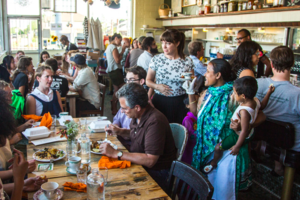Bringing Culture over the Lines
Author: Vanessa Velazquez
East Lansing is home to a large variety of people that make up Michigan State University’s campus, but more importantly, the local community. It is a known fact that people crave a functioning sense of community. Within this community a new culture develops due to the influence of the unique cultures that are in the area. Culture is the collection of people with their many identities that have to live, work, and breathe in the same geographical region. However, in East Lansing the community is always evolving and always changing, these changes can cause the community to have mixed emotions of the culture in this city.
In a historical context, the clash of cultures has created devastating outcomes; war, segregation, intolerance, etc. Those extremes may not be the case for East Lansing but when looking at Greater Lansing there is segregation, there has been a history of intolerance. So how can implementation of culture change the current status quo? Let’s start with who lives in East Lansing. Within Michigan State University there are approximately 50,344 students in undergraduate and graduate programs; 39,090 undergraduates and 11,254 graduates. Out of this 50,344, 61% do not live on MSU’s campus, rather in the surrounding areas for the most part. When analyzed alone, this vast Spartan community is connected into through educational affiliation and phrases like “Spartans Will”. When mixed into the outer boundaries the culture behind “Spartans Will” does not diminish but is challenged but the local residents that will not move in 4 to 5 years like most students do. When challenged, these two groups may not be realizing the opportunity they have by embracing each others differences.
There is a division between these two groups, that is why there needs to be a cultural evolution in East Lansing. The group of temporary residents that may be students, non-tenured professors, or any faculty clash with the permanent residents that have made East Lansing a home. Bringing culture over these boundary lines can make East Lansing more than just a pit spot for some and help the residents be more welcoming in developing a stronger community. Homes are what the person makes of it but also where they feel comfortable to be themselves in order to make the most out of it.
A group of women were able to create a cultural evolution that was able to empower women, encourage economic gain, and combat intolerance of immigrants in Hamtramck and Detroit. Minara Begum is an immigrant from Bangladesh that started gardening traditional South Asian crops for her family, she found a way to still stay true to her cultural way of living in Detroit. This idea would turn in Bandhu Gardens, a community garden that six families tend to and sell surplus vegetables to local restaurants, Eastern Market, and hold pop-up dinners. This farming brought women together that were also Bangladeshi but also Middle Eastern and locals. The language barriers that they were overcame by constant effort and the farming itself. On the border of Hamtramck and Detroit, this area is now nicknamed BanglaTown because of this new united community. This also has further the evidence that supports urban farming, in places like Detroit that have been food deserts, this community is changing the everyday lives that people once lived. Most importantly, a pluralistic culture has now been stimulated in a region of Detroit that has always been segregated.
The United States likes to use the phrase “melting pot” when they best see fit, however, East Lansing has the potential to really exemplify what that means and come together through community engagement like Hamtramck and Detroit did. There are so many international students at Michigan State University that still report feeling unwelcomed because they are international. MSU was the agricultural cultural college of Michigan, therefore, we have many students from rural America that also go through culture shocks when going to college, let alone a Big Ten College. There are so many other different identities that can be better infused together to create an East Lansing that wants to continue learning and growing from one another inviting change everyday.
An example of this principle at work: Bandhu Gardens
Back